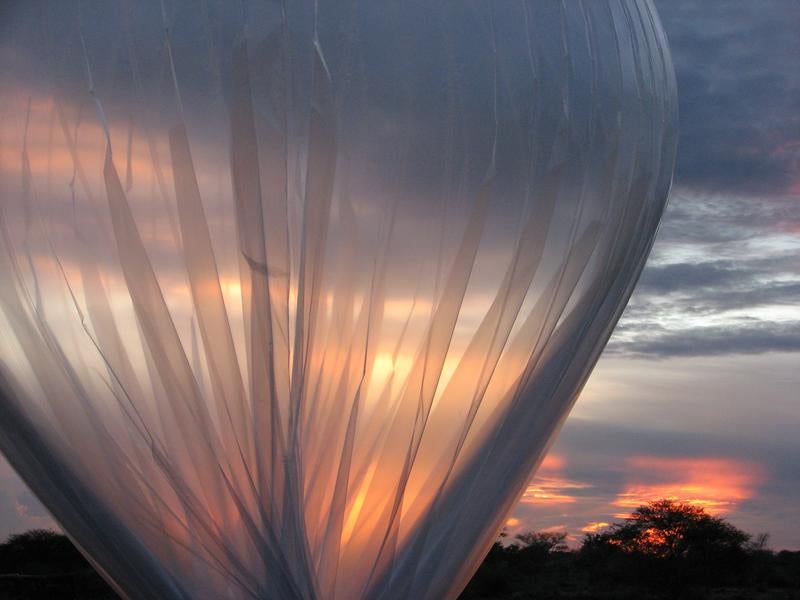Driftsonde
 The driftsonde observing system was developed to support research associated with the WMO's THORPEX program. The major goal for the driftsonde program was a low-cost measurement system that can produce vertical profiles of in-situ measurements in forecast sensitive regions (.i.e. targeted areas where numerical models predict that such measurements would improve the prediction of high impact weather events) as well as make soundings that will fill critical gaps in data coverage over oceanic and remote arctic and continental regions.
The driftsonde observing system was developed to support research associated with the WMO's THORPEX program. The major goal for the driftsonde program was a low-cost measurement system that can produce vertical profiles of in-situ measurements in forecast sensitive regions (.i.e. targeted areas where numerical models predict that such measurements would improve the prediction of high impact weather events) as well as make soundings that will fill critical gaps in data coverage over oceanic and remote arctic and continental regions.
Forecast sensitive regions that would be targeted for driftsondes are (1) relatively void of in-situ measurements from radiosondes and commercial aircraft, (2) covered with extensive cloud shields so that satellite measurements are limited. The across the ocean driftsonde flights will provide synoptic-scale high-vertical resolution atmospheric profiles made by GPS dropsondes that would be difficult or impossible to obtain by deployment of aircraft alone.
The targeting ability of the driftsonde was accomplished by controlling the launch location, the launch time of the balloon, the time of dropsonde deployment and to a limited extent the initial mission altitude (i.e. the wind field). The GPS dropsondes measured wind, temperature, pressure and relative humidity.
The driftsonde system consisted of a low-cost zero-pressure polyethylene balloon with a duration of approximately five to seven days or a moderate duration super pressure balloon that could fly for weeks to months. Housed in the gondola was the system electronics which includes an embedded computer, a GPS navigation system, flight level PTH sensors, a ballast control system, a battery power system, an Iridium satellite two-way communication system, and up to approximately 60 dropsonde tubes for the new MIST dropsonde.
Each of the lightweight dropsondes could be dropped at predetermined times by computer or on command through the satellite link. The driftsonde balloons flew at an altitude of 16 kilometers up to 30 kilometers (100 - 10 hPa) in the lower stratosphere or upper troposphere above the clouds and weather systems. Three sizes of zero pressure (zp) balloons had been developed and one size super pressure (sp) balloon: (1) a 100 hPa or 363 cu meter zp balloon, (2) a 50 hPa or 1200 cu meter zp balloon, (3) a 10 hPa 10,000 cu meter zp French (CNES) balloon and (4) a 50 hPa 12 meter diameter sp French (CNES) balloon. A THORPEX driftsonde demonstration project with the French (CNES) for the African Monsoon experiment (AMMA) was carried out in August - September 2006 from Niger that utilized the new French 12 meter diameter super pressure balloon and the NCAR driftsonde gondola carrying up to 40 MIST dropsondes and flying at ~50 hPa (~20 km) to study African easterly waves that can result in the genesis of Atlantic Hurricanes.
Balloon Type: Either a 4 to 7 day Zero Pressure balloon (e.g. 363 cu. meter for an altitude of 100 mb up to a 10,000 cu. meter for an altitude of 10 mb) or a Super Pressure balloon (e.g. 12 meter diameter for an altitude of 10 mb) that can fly for weeks or even months.
Scientific Payload: A typical gondola weight with 50 GPS dropsondes is ~22 kgms. Other scientific instruments was integrated into the on board system for flight level measurements.
Launch Site Requirements: Some type of shelter for protection of the balloon during inflation (e.g. Hangar) along with a reasonably flat smooth area for launch (e.g. in front of hangar). The wind speed should be below 10 knots during balloon launch.